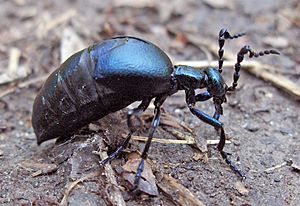Meloe facts for kids
Quick facts for kids Meloe |
|
|---|---|
 |
|
| Meloe violaceus | |
| Scientific classification |
|
| Kingdom: | Animalia |
| Phylum: | Arthropoda |
| Class: | Insecta |
| Order: | Coleoptera |
| Family: | Meloidae |
| Subfamily: | Meloinae |
| Genus: | Meloe Linnaeus, 1758 |
| Species | |
|
See text |
|
Meloe is a group of blister beetles often called oil beetles. They get this name from a cool defense trick. When they feel threatened, like by a predator, they release oily drops of fluid from their leg joints. This fluid is bright orange and contains a poisonous chemical called cantharidin. If it gets on your skin, it can cause blisters and painful swelling. This special defense is used by all beetles in the Meloe group.
Contents
What Oil Beetles Look Like
Oil beetles usually have short wing covers, called elytra. These wing covers are too short for them to fly. They often shine with colors like blue, green, or black. Their bodies have small pits or bumps on their wing covers and chest area. They also have a large, round belly. Male oil beetles have special bends or "kinks" in their antennae. These kinks look different in various species.
Amazing Life Cycle
Oil beetles have a very unusual way of growing up. It's called hypermetamorphosis, which means they change their body shape many times.
Tiny Travelers: The Larva Stage
The first stage of an oil beetle larva is a tiny, active creature called a triungulin. This larva's main goal is to find a host, usually a bee. It climbs onto a flower and waits for a bee to visit. When a bee lands, the tiny larva quickly attaches itself.
If the bee is a male, the larva waits until the male bee mates with a female. Then, it quickly switches over to the female bee. If the bee is already a female, she unknowingly carries the larva back to her nest.
Growing Up in a Bee Nest
Once inside the bee's nest, the oil beetle larva changes. It becomes a grub-like creature that stays put. It then eats all the food the bee collected for its own babies. It might even eat the bee's larva too! After eating, the oil beetle larva forms a pupa, which is like a cocoon. Then, it changes into an adult beetle. This can happen at different times of the year, depending on the specific oil beetle species.
Some oil beetle species only attack one type of bee. Others are less picky and can use many different kinds of bees as hosts.
Adult Life and Reproduction
After growing up underground, adult oil beetles come out. They eat plants from families like buttercups (Ranunculaceae) and morning glories (Ipomoaceae). Oil beetles are known for having a huge appetite!
When it's time to mate, a male oil beetle climbs onto a female. He uses the kinks on his antennae to gently touch and pull her antennae. This helps to calm the female. During mating, the male passes some of his cantharidin (the poisonous chemical) to the female. She then uses this chemical to coat her eggs, which helps protect them.
Species of Oil Beetles
There are many different kinds of oil beetles. Here are just a few examples:
- Meloe americanus
- Meloe angusticollis – also known as the short-winged blister beetle
- Meloe brevicollis – known as the short-necked oil beetle
- Meloe laevis – a common oil beetle
- Meloe proscarabaeus – the black oil beetle
- Meloe rugosus – known as the rugged oil beetle
- Meloe violaceus – the violet oil beetle
See also
 In Spanish: Carralejas para niños
In Spanish: Carralejas para niños


